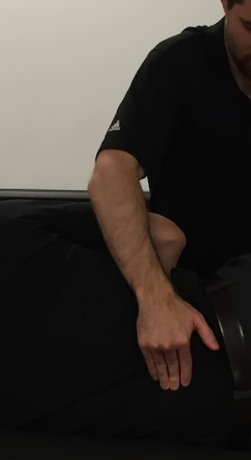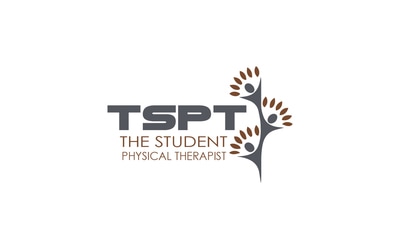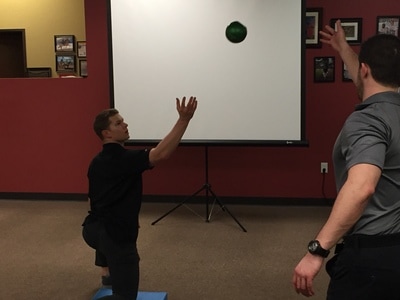- Home
- About Us
- TSPT Academy
- Online Courses
-
Resources
- Newsletter
- Business Minded Sports Physio Podcast
- Day in the Life of a Sports PT
- Residency Corner
-
Special Tests
>
-
Cervical Spine
>
- Alar Ligament Test
- Bakody's Sign
- Cervical Distraction Test
- Cervical Rotation Lateral Flexion Test
- Craniocervical Flexion Test (CCFT)
- Deep Neck Flexor Endurance Test
- Posterior-Anterior Segmental Mobility
- Segmental Mobility
- Sharp-Purser Test
- Spurling's Maneuver
- Transverse Ligament Test
- ULNT - Median
- ULNT - Radial
- ULNT - Ulnar
- Vertebral Artery Test
- Thoracic Spine >
-
Lumbar Spine/Sacroiliac Joint
>
- Active Sit-Up Test
- Alternate Gillet Test
- Crossed Straight Leg Raise Test
- Extensor Endurance Test
- FABER Test
- Fortin's Sign
- Gaenslen Test
- Gillet Test
- Gower's Sign
- Lumbar Quadrant Test
- POSH Test
- Posteroanterior Mobility
- Prone Knee Bend Test
- Prone Instability Test
- Resisted Abduction Test
- Sacral Clearing Test
- Seated Forward Flexion Test
- SIJ Compression/Distraction Test
- Slump Test
- Sphinx Test
- Spine Rotators & Multifidus Test
- Squish Test
- Standing Forward Flexion Test
- Straight Leg Raise Test
- Supine to Long Sit Test
-
Shoulder
>
- Active Compression Test
- Anterior Apprehension
- Biceps Load Test II
- Drop Arm Sign
- External Rotation Lag Sign
- Hawkins-Kennedy Impingement Sign
- Horizontal Adduction Test
- Internal Rotation Lag Sign
- Jobe Test
- Ludington's Test
- Neer Test
- Painful Arc Sign
- Pronated Load Test
- Resisted Supination External Rotation Test
- Speed's Test
- Posterior Apprehension
- Sulcus Sign
- Thoracic Outlet Tests >
- Yergason's Test
- Elbow >
- Wrist/Hand >
- Hip >
- Knee >
- Foot/Ankle >
-
Cervical Spine
>
- I want Financial Freedom
- I want Professional Growth
- I want Clinical Mastery
Finkelstein Test
Purpose: To assess for the presence of DeQuevain's disease.
Test Position: Sitting or standing.
Performing the Test: The patient actively (or active assistive) flexes thumb maximally and wraps fingers over thumb, making a fist. The patient then ulnarly deviates his/her wrist to stretch the muscles of the 1st extensor compartment. The test is positive if the patient complains of pain over the 1st extensor compartment of the wrist.
Diagnostic Accuracy: Unknown.
Importance of Test: The muscles that cross the wrist are separated into compartments by the extensor retinaculum. In the first compartment, the tendons of the extensor pollicis brevis and abductor pollicis longus pass through to attach distally. According to Neumann, the extensor pollicis brevis attaches distally to the dorsal side of the proximal phalanx and extensor mechanism of the thumb, while the abductor pollicis longus attaches distally to the radial-dorsal side of the 1st metacarpal. The combination of maximum finger flexion and wrist ulnar deviation elongates these tendons and produces pain in symptomatic individuals.
Note: these tests should only be performed by properly trained health care practitioners.
Test Position: Sitting or standing.
Performing the Test: The patient actively (or active assistive) flexes thumb maximally and wraps fingers over thumb, making a fist. The patient then ulnarly deviates his/her wrist to stretch the muscles of the 1st extensor compartment. The test is positive if the patient complains of pain over the 1st extensor compartment of the wrist.
Diagnostic Accuracy: Unknown.
Importance of Test: The muscles that cross the wrist are separated into compartments by the extensor retinaculum. In the first compartment, the tendons of the extensor pollicis brevis and abductor pollicis longus pass through to attach distally. According to Neumann, the extensor pollicis brevis attaches distally to the dorsal side of the proximal phalanx and extensor mechanism of the thumb, while the abductor pollicis longus attaches distally to the radial-dorsal side of the 1st metacarpal. The combination of maximum finger flexion and wrist ulnar deviation elongates these tendons and produces pain in symptomatic individuals.
Note: these tests should only be performed by properly trained health care practitioners.
Reference:
Neumann, Donald. Kinesiology of the Musculoskeletal System: Foundations for Rehabilitation. 2nd edition. St. Louis, MO: Mosby Elsevier, 2010. 303. Print.
Neumann, Donald. Kinesiology of the Musculoskeletal System: Foundations for Rehabilitation. 2nd edition. St. Louis, MO: Mosby Elsevier, 2010. 303. Print.
Copyright © The Student Physical Therapist LLC 2023



